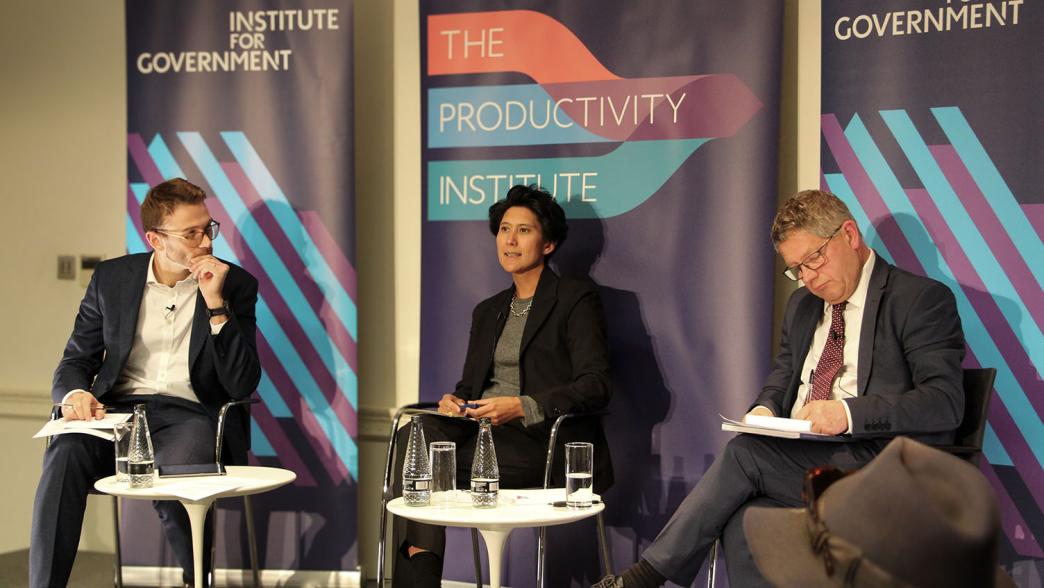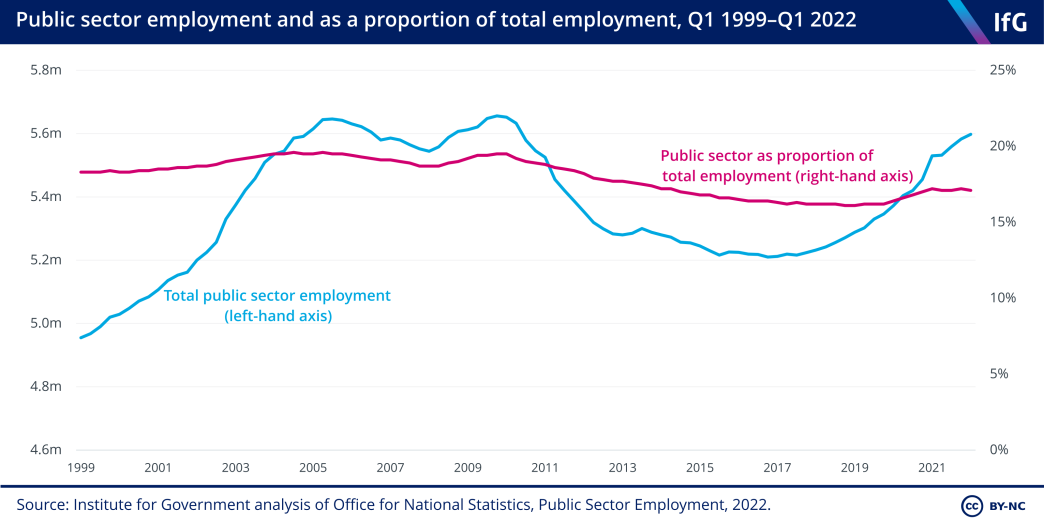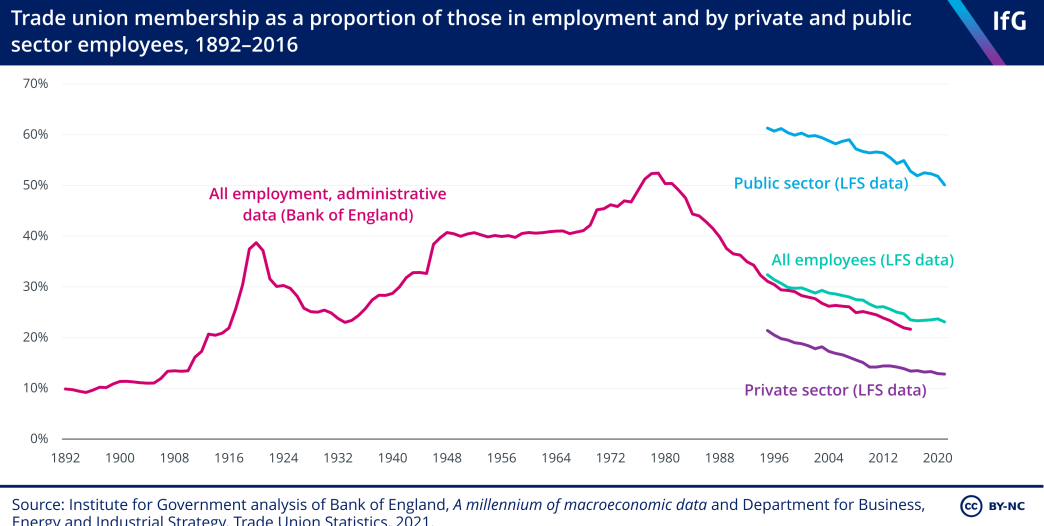Public sector pay and employment
This explainer outlines how public sector pay is set.

Since late 2021, inflation in the UK has risen to a level not seen in 40 years. With incomes failing to keep pace, real incomes have fallen. This has led to calls from trade unions for the government to increase public sector wages in line with inflation to protect real earnings. This explainer outlines how public sector pay is set.
How many people work in the public sector?
The public sector consists of all workers employed by the state – whether UK government departments, the devolved governments, local authorities or other government agencies and public bodies. But it excludes organisations such as museums and universities which receive significant taxpayer funding and are often viewed as public services but are private sector organisations.
The number of people employed by the public sector decreased by nearly 8% in absolute terms from the peak in 2009 to 2016. The number then started to rise again, thanks to the demands that Brexit and Covid placed on the public sector. There are now 5.6 million people employed by the public sector, just 1% fewer than there were in 2009.
However, public sector employment as a proportion of all people working has remained on a slight downward trajectory (fractionally increasing during the pandemic) because of faster employment growth in the private sector. The public sector now makes up 17.5% of total employment.

However, these overall trends mask significant variation in employment trends within the public sector. The NHS employs 23% more people than it did in 2009, for example. By contrast, the armed forces are around 20% smaller and local government has shrunk considerably too, having lost around a third of its workforce – almost a million employees – since its peak in 2009.
How much money is spent on public sector pay?
The total public sector pay bill was around £235 billion in the 2021/22 financial year – with central government pay (which includes UK government departments, parliament, most public bodies and the devolved administrations) costing about £165 billion and local government about £70 billion. 23 HM Treasury, Public Expenditure Statistical Analyses 2022, 20 July 2022, www.gov.uk/government/statistics/public-expenditure-statistical-analyses-2022 Public sector pay accounts for around a quarter of all government spending. 24 HM Treasury, Spending Review 2020, https://assets.publishing.service.gov.uk/government/uploads/system/uploads/attachment_data/file/938052/SR20_Web_Accessible.pdf
What fraction of public sector workers belong to a union?
Trade union membership – and collective bargaining, when employee pay and conditions are agreed in negotiations between employers and trade unions – is higher in the public sector than the private sector. However, the proportion of workers in both sectors who belong to a union has been in steady decline for many decades.
In 2021, 12.8% of private sector employees and 50.1% of public sector employees were members of trade unions – both record lows. Trade union membership peaked in 1979, when 52.4% of those in employment (or 13.2 million people) belonged to a union. 25 Bank of England, Research datasets, www.bankofengland.co.uk/statistics/research-datasets This proportion declined steadily thereafter, reaching 21.7% (or 6.9 million people) in 2016. 26 Department for Business, Energy and Industrial Strategy and the Office for National Statistics, Trade Union Membership, UK 1995-2021: Statistical Bulletin, https://assets.publishing.service.gov.uk/government/uploads/system/uploads/attachment_data/file/1077904/Trade_Union_Membership_UK_1995-2021_statistic…

How is public sector pay set?
Pay review bodies
The government ultimately decides the level of public sector pay (or in the case of public services such as the NHS which are devolved, the devolved governments set their own arrangements). However, there is a lengthy process – involving independent pay review bodies – that informs the final government decision.
Around 45% of public sector staff are covered by pay review bodies. These cover: most NHS staff; including doctors and dentists; the armed forces; prison staff; teachers; the police; the National Crime Agency; and senior public officials. The latter includes judges, senior civil servants, senior members of the armed forces, senior police officers, and the most senior NHS managers.
Pay review bodies all follow a similar procedure when advising the government on pay. First, the relevant secretary of state issues a remit letter to the pay review body covering sectors overseen by their department (so the home secretary would issue a remit letter for the police and National Crime Agency remuneration review bodies, for example). Normally, secretaries of state will use their remit letter to formally request recommendations on employee pay and ask pay review bodies to consider certain objectives such as affordability, recruitment and retention and the state of the wider labour market. When the government has an overarching public sector pay policy that overrides the pay review bodies process (see below), secretaries of state will ask for the views of the pay review body on how to implement this overarching policy.
Following this, pay review bodies then receive evidence from a range of sources, such as trade unions and employers on issues relating to pay and retention. At this time, the government also submits its formal pay offer. This is a detailed series of proposals on the future level of pay for specific groups of employees. For example, HM Prisons and Probation Service’s submission to the Prison Service Pay Review Body for the latest (2022/23) pay round contained 12 separate proposals covering all staffing grades, increases in grades, restructuring of pay bands and allowances.
In light of this evidence, pay review bodies then make a recommendation to the government on the level of pay. The UK government determines when it will respond to and publish the reports of pay review bodies. 32 Ministry of Justice and Prison Service Pay Review Body, Remit letter for the PSPRB 2022 England and Wales pay round, 3 December 2021, www.gov.uk/government/publications/remit-letter-for-the-psprb-2022-england-and-wales-pay-round Secretaries of state usually respond to pay review body recommendations through issuing a written ministerial statement in parliament.
The recommendations of pay review bodies are usually accepted by the government. However, there have been times when the government has over-ridden their recommendations – for example, imposing public sector pay caps or even freezes. Public sector pay was frozen for two years from 2010 for all but lower-paid staff and awards were limited to an average of 1% between 2013 and 2017. Public sector wages were also frozen during the 2021/22 pay round due to the coronavirus pandemic, meaning public sector workers received the same pay in 2021/22 as in 2020/21. The only exceptions were those earning less than £24,000 a year, who were guaranteed a pay increase of at least £250, and NHS workers. 33 HM Treasury and The Rt Hon Rishi Sunak MP, Spending Review 2020 speech, www.gov.uk/government/speeches/spending-review-2020-speech Remit letters sent by secretaries of state to pay review bodies took account of this and asked for advice on how to implement the £250 rise for lower paid workers.
Other pay settlements
The situation is a little different for public sector workers who are not covered by pay review bodies.
- For civil servants not in the Senior Civil Service (who are covered by the Senior Salaries Review Body), individual departments set the pay of their officials, according to guidance issued by the Treasury and Cabinet Office. 34 Cabinet Office, 'Pay reporting to HMT' in Civil Service Pay Remit guidance, 2022 to 2023, 31 March 2022, www.gov.uk/government/publications/civil-service-pay-remit-guidance-2022-to-2023/civil-service-pay-remit-guidance-2022-to-2023#section5 Bonuses (known as non-consolidated performance payments) are awarded annually to staff based on their performance at an individual, team or organisational level. 35 Cabinet Office, 'Glossary of terms' in Civil service pay remit guidance 2019 to 2020, 13 June 2019, www.gov.uk/government/publications/civil-service-pay-remit-guidance-2019-to-2020/civil-service-pay-remit-guidance-2019-to-2020#glossary-of-terms
- Local government staff (with the exception of schoolteachers) are also not covered by pay review bodies. Decisions on pay for these workers are agreed between employers and trade unions through the National Joint Council for Local Government Services. 36 House of Commons Library, Public sector pay, 28 October 2022, https://commonslibrary.parliament.uk/research-briefings/cbp-8037/#:~:text=Pay%20awards%20for%20local%20government%20workers%20are%20agreed,policy%20i…;
- The devolved governments set pay policy for public bodies under their control.
How much will public sector pay rise this year?
Recommendations from all the pay review bodies (except for the National Crime Agency) which will inform pay rises for the 2022/23 financial year were published alongside the government’s response on 19 July 2022. As the pay review bodies have reported after the financial year started (which was at the beginning of April), most pay increases will not be implemented until the autumn but will be backdated to the start of April.
Pay review body |
Headline recommendation from pay review body |
Government response |
|---|---|---|
| Armed Forces’ Pay Review Body (AFPRB) | Increase rates of base pay for all armed forces by 3.75% from 1 April 2022 | Accepted in full |
| Review Body on Doctors’ and Dentists’ Remuneration (DDRB) | Increase national salary scales, pay ranges or the pay element of contracts by 4.5% from 1 April 2022 | Accepted in full |
| NHS Pay Review Body (NHSPRB) | £1,400 consolidated uplift for staff on Agenda for Change contracts and an enhanced uplift of 4% for staff in bands 6 and 7 backdated to 1 April 2022. | Accepted in full |
| Prison Service Pay Review Body (PSPRB) |
Pay rise of at least 4% for prison staff on bands 2-11 (Operational Support Grade to Senior Governors) from 1 April 2022 as well as various grade structuring and within grade pay progression recommendations Pay rise of 5% for band 12 (Prison Group Directors) from 1 April 2022*. |
Partially accepted – 12 out of 13 separate recommendations accepted Recommendation to increase band 12 spot rate by 5% was not accepted; this was increased by 3% instead |
| School Teachers’ Review Body (STRB) |
Pay increases of between 5% (for top four pay bands) and 8.9% (for newly qualified teachers outside London) from September 2022 Increase all allowance ranges and advisory points for non-classroom teachers by 5% |
Accepted in full |
| Senior Salaries Review Body (SSRB) | SCS: increase of 3% for all SCS from 1 April 2022 and further 0.5% pot to allow pay band minima to be increased and to address other pay anomalies |
Partially accepted by Cabinet Office:
|
| Senior military: 3.5% consolidated increase to base pay | Accepted in full by MoD | |
| Judges: 3.5% pay increase | Not accepted by MoJ | |
| NHS Senior management: increase of 3% for all from 1 April 2022 and further 0.5 per cent to ameliorate the erosion of differentials | Accepted in full by DHSC | |
|
PCCs: move to 3 pay groups (Group 1: £108.8k; Group 2: £94.3k; Group 3: £83.2k) This would be a 8.8%–25.5% increase for PCCs. |
Not accepted by Home Office: PCC salaries to increase by £1,900 (worth 2%–3%) as per police officer award from 1 May 2022 | |
| Police Remuneration Review Body (PRRB) | Consolidated increase of £1,900 for all police officers; increase minimum starting salary for PC Degree Apprentice by £4,392 and increase London Weighting and the Dog Handlers’ Allowance by 5% from 1 September 2022* | Accepted in full |
| National Crime Agency Remuneration Review Body (NCARRB) | Published in February 2023 a 5% increase in remuneration costs which should take the form of £1,900 basic pay uplift for all officers Grade 1-6 | Accepted in full |
*England and Wales only
- Position
- Chancellor of the exchequer
- Department
- HM Treasury
- Publisher
- Institute for Government